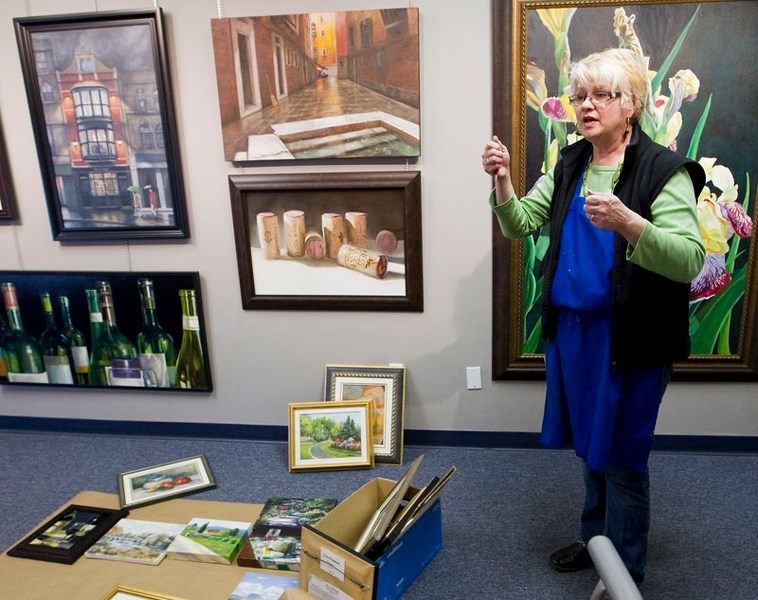There’s more to hanging pictures than hammering a nail in the wall. Creating a pleasing display of your favourite photos takes an artful eye and some thoughtful planning.
If you want to know how your pictures will look on the wall, try putting them down on the floor first so you can play with the shapes and the colours before you start making holes in the plaster.
“It’s the best way, especially if you’re working with a group of pictures,” said Laura Watmough, owner of Hidden Talent Fine Arts School and Gallery.
To demonstrate some basic design principles, Watmough places a number of paintings on the floor on top of a piece of brown paper.
She starts with 10 of her own paintings. As she moves them around it soon becomes obvious that they don’t all work when placed together as a group. There are three still-life paintings and all of them seem to fight for attention with the various landscapes in the mix.
“Perhaps, even if you had a big wall, these paintings might be better in two different groupings. It works best if there is something that connects the art in some way,” Watmough says, as she further narrows her choice of landscapes down to just five. Each piece in this final group contains a hint of green, which provides the subtle, unifying force that makes the grouping work.
Watmough shows that, by placing the bigger two paintings on top and the smaller paintings on the bottom, her collage of paintings seems out of whack. Next she puts the bigger paintings on one side and lines up the other three up beside them.
“Our eye likes symmetry and it likes balance and we like things that are heavier or bigger to be lower than the smaller items,” she says as she demonstrates how the spacing between paintings is also important.
“There has to be what we call visual tension between the items. They have to feel connected. If you move them too far apart, they become a separate entity again,” she says.
That spacing is also important in relationship to pieces of furniture. When paintings are hung just a few inches above a couch, it helps to ground the entire arrangement and feels warmer and more inviting.
“The grouping works better if it seems to be related to the chesterfield. The bottom piece should be only six to eight inches (about the width of your hand) above the chesterfield. At the same time, if you had a big honking frame, that people might bump their heads on, you might move it up, perhaps to 10 inches above a bed frame or above a couch, ” Watmough says.
Grouping paintings together with souvenirs or special pieces of glass or china is a good way to create visual impact, especially if you have a small budget, says interior designer Sheri Krug.
“Maybe you have a special vase, with some special meaning to you. Put it on a shelf on brackets and make it part of your grouping. The grouping becomes a new piece of art, but it’s not arbitrary art. It’s a grouping that is made of very personal objects,” Krug says.
Like Watmough, Krug likes items that are related in some way.
“Trust yourself because your brain knows balance and proportion and scale, unless you want chaos, and chaos doesn’t usually do well in house design. Usually if it is balanced in some way, or the objects are related in some way, it feels comfortable,” Krug says.
Krug also emphasizes that, when possible, it’s a good idea to consult with the artist who created the painting.
“If you’re hanging art, get the artist’s perspective if you can. I’ve seen sometimes when an abstract painting has been hung upside down,” she says.
When it comes to actually hammering in the nails, neither Watmough nor Krug use fancy devices like lasers to help with measuring.
“Sometimes walls, especially in older homes are uneven and a laser doesn’t work very well,” Krug says.
Watmough continues to use her brown paper as a guide to line up the position of the nails on the wall. She cuts the paper to exactly match the size of each painting. She also notes the position of the string hanger on the back of the art and marks that place on her brown paper. She sticks the paper on the wall with painter’s tape and hammers the nail in right through the paper.
Both Krug and Watmough stress that, if you love your art and if it has meaning to you, it will always work in your overall decorating scheme because it reflects your personality. Your art should be about you, your interests and perhaps your dreams.
“Every rule can be broken, but I would say, don’t try to match the couch. In fact, I would say it’s imperative that it not match the couch,” Watmough says. “You will have art that you love much longer than you have a chesterfield. Art is like a weathervane that reflects the mood of your house.”




